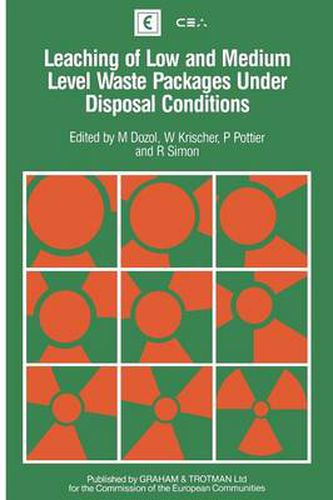Readings Newsletter
Become a Readings Member to make your shopping experience even easier.
Sign in or sign up for free!
You’re not far away from qualifying for FREE standard shipping within Australia
You’ve qualified for FREE standard shipping within Australia
The cart is loading…






This title is printed to order. This book may have been self-published. If so, we cannot guarantee the quality of the content. In the main most books will have gone through the editing process however some may not. We therefore suggest that you be aware of this before ordering this book. If in doubt check either the author or publisher’s details as we are unable to accept any returns unless they are faulty. Please contact us if you have any questions.
Leaching tests are conducted according to different standards, pro cedures or recommendations, generally under conditions different from those of the disposal media. Such tests are generally useful for com paring various containment matrices to ensure maximum isolation of radionuclides, and allow waste conditioning processes to be optimized. However, when defining release hypotheses to be taken into consideration for risk analysis, these methods can often lead to hypothesis which are either too optimistic or too pessimistic. The uncertainties basically involve the processes by which containers deteriorate during transport, handling and utlimate storage. Moreover, the interpretation of test results must be more clearly correlated with the known physico-chemical mechanisms involved. In attempting to find an answer to this question, tests have already the recovery been undertaken, including the use of lysimeter devices or of waste materials after several years of storage. The aim of the seminar was to exchange views among experts in characterization, waste management and safety analysis for the purpose of defining the principal actions that could be undertaken or of reorienting ongoing studies in order to limit the uncertainties involved.
$9.00 standard shipping within Australia
FREE standard shipping within Australia for orders over $100.00
Express & International shipping calculated at checkout
This title is printed to order. This book may have been self-published. If so, we cannot guarantee the quality of the content. In the main most books will have gone through the editing process however some may not. We therefore suggest that you be aware of this before ordering this book. If in doubt check either the author or publisher’s details as we are unable to accept any returns unless they are faulty. Please contact us if you have any questions.
Leaching tests are conducted according to different standards, pro cedures or recommendations, generally under conditions different from those of the disposal media. Such tests are generally useful for com paring various containment matrices to ensure maximum isolation of radionuclides, and allow waste conditioning processes to be optimized. However, when defining release hypotheses to be taken into consideration for risk analysis, these methods can often lead to hypothesis which are either too optimistic or too pessimistic. The uncertainties basically involve the processes by which containers deteriorate during transport, handling and utlimate storage. Moreover, the interpretation of test results must be more clearly correlated with the known physico-chemical mechanisms involved. In attempting to find an answer to this question, tests have already the recovery been undertaken, including the use of lysimeter devices or of waste materials after several years of storage. The aim of the seminar was to exchange views among experts in characterization, waste management and safety analysis for the purpose of defining the principal actions that could be undertaken or of reorienting ongoing studies in order to limit the uncertainties involved.